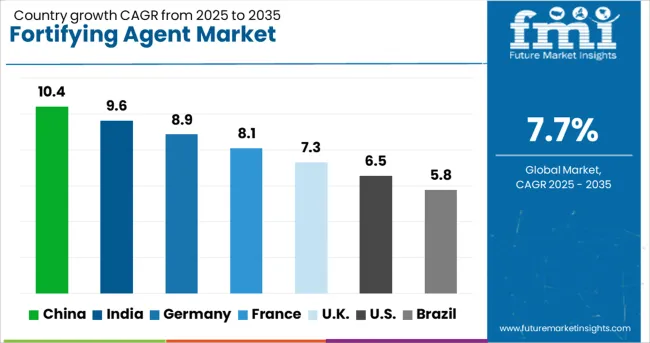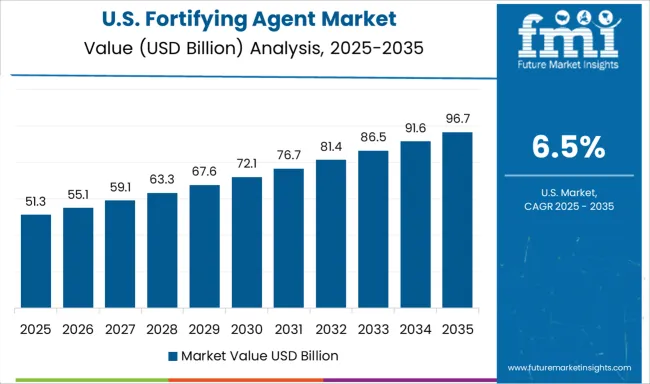The Fortifying Agent Market is estimated to be valued at USD 100.3 billion in 2025 and is projected to reach USD 210.6 billion by 2035, registering a compound annual growth rate (CAGR) of 7.7% over the forecast period.
| Metric | Value |
|---|---|
| Fortifying Agent Market Estimated Value in (2025 E) | USD 100.3 billion |
| Fortifying Agent Market Forecast Value in (2035 F) | USD 210.6 billion |
| Forecast CAGR (2025 to 2035) | 7.7% |
Fortification agents in food are the process of the addition of micronutrients and vitamins to food products where food becomes more nutritious once it has been fortified. This procedure is used by food manufacturers to increase micronutrients and vitamins in their goods by adding fortification agents. Fortification agents are utilized in staple foods to reduce the dietary deficit and to boost the nutrients in dietary food and cereals, fortifying agents are used.
Fortifying agent sales grew at a CAGR of 7.2% between 2020 and 2025. The period marked the entry of various market players and product innovations.
The increased demand for healthful foods is the primary driver of fortifying agents. Because of the changing lifestyles, consumers are becoming more conscious of healthy food products. Numerous issues function as roadblocks to the market expansion of fortifying agents.
Moreover, toxins are produced in the body as a result of excessive absorption of dietary fortifying agents. Vitamins A, D, and E are fat-soluble vitamins that are absorbed into fat and saturate the body's supply.
Fortifying agents are used to improving the nutritional content of food. It aids in the reduction of chronic diseases caused by a lack of nutritional diets, such as high blood pressure, cardiovascular disease, Alzheimer's disease, and many others. The first sort of food fortification is compulsory, whereas the second type is optional. The FDA has set criteria and requirements for required food fortification.
Pharmaceuticals and pet food manufacturers both utilize fortifying agents. Minerals, vitamins, lipids, carbs, proteins, and other food fortifying agents are only a few examples. Because of their local soil and a dearth of staple foods, consumers' diets in various locations may be deficient in specific nutrients, increasing in demand for food fortifying agents. Food fortifying agents can be found in milk, cereals, and nutritional foods.
Vitamin C fortification is used in beverages and juices to increase vitamin C content; calcium and phosphorus fortification is used in the newborn formula, and vitamin A fortification is used in milk. As the global population of people who are malnourished grows, so does the demand for food fortifying agents.


The USA is one of dominating markets for fortifying agents and sales as the rising demand for nutritional enriched products is rising in the country.
Additionally, consumers choose healthier food as chronic diseases and obesity become more prevalent, pushing the market for fortifying agents. Moreover, the market for fortified foods is predicted to develop in the USA as people become more aware of nutrient deficiencies such as iodine, vitamin A & D, and myopia.
Fortifying agents in China are likely to be driven by the Chinese Ministry of Health's promotion of fortified foods, as well as growing health concerns connected to age, myopia in adults, and other disorders. However, in China, lower income and awareness levels, as well as the limited practicality of lucrative distribution to rural areas, provided a significant impediment to the growth of the fortified agent business.
In India, the market for fortifying agents is rapidly expanding. Food fortification has been identified by the Food and Agricultural Organization (FAO) and the World Health Organization (WHO) as one of the most important measures for reducing malnutrition in developing nations. As a result, the use of fortifying agents is becoming more common in the business. Fortifying agents are utilized in developing countries like India to bridge the gap between agriculture and nutrition.
Additionally, the key restriction in this industry is the high cost of fortification agents. The level of the fortification varies depending on the food manufacturer in the region. The majority of food manufacturing companies use fortification to improve the quality of their products.
Due to the rising frequency of disorders caused by vitamin deficiency, such as rickets and osteoporosis, rising healthcare costs, and a growing aging population, During the projection period, the vitamin segment held the largest share of the fortifying agents market in terms of value.
Additionally, vitamins are required for immunological function, energy synthesis, blood coagulation, and a variety of other processes. Minerals, on the other hand, are essential for bone health, growth, fluid equilibrium, and a variety of other processes. This is why the sales of vitamins are expected to grow with a CAGR of 8.4% in the forecasted period.
Cereals, dairy, fats and oils, and infant food items are some of the biggest consumers of fortifying agents. Food quality and nutrition have improved, allowing them to be used in a wider range of applications in the food sector, including bakery, breakfast foods, and beverages. The use of fortifying agents in baked goods such as biscuits, cookies, cakes, pastries, and bread is quickly rising.
Consumers are more likely to consume food items with higher health advantages if the price is not a factor. During the projection period, an increased number of food items using novel fortifying agents are predicted to hit the market.
The Fortifying Agent market is fragmented, with the leading companies driving growth. Investments and expansions have emerged as the most popular method for gaining and retaining new clients around the world among major players. They also focused on purchasing up-and-coming local players to expand their business on a global scale while maintaining market competitiveness.
| Attribute | Details |
|---|---|
| Forecast Period | 2025 to 2035 |
| Historical Data Available for | 2020 to 2024 |
| Market Analysis | USD Billion for Value and Metric Ton for Volume |
| Key Regions Covered | North America; Latin America; Europe; East Asia; South Asia; Oceania; and Middle East & Africa |
| Key Countries Covered | United States, Canada, Brazil, Mexico, Germany, UK, France, Italy, Spain, Nordic, Russia, Poland, China, Japan, South Korea, India, Thailand, Indonesia, Malaysia, Singapore, Australia, New Zealand, GCC countries, North Africa, South Africa, others. |
| Key Segments Covered | Agent Type, Form, Application, and Region |
| Key Companies Profiled | Cargill, Incorporated; Royal DSM; CHR. Hansen Holdings A/S; E. I. du Pont de Nemours and Company; BASF SE; Arla Foods; Tate & Lyle; Ingredion; The Archer Daniels Midland Company; Nestle SA; Others (on additional request) |
| Report Coverage | Market Forecast, Company Share Analysis, Competition Intelligence, DROT Analysis, Market Dynamics and Challenges, and Strategic Growth Initiatives |
| Customization & Pricing | Available upon Request |
The global fortifying agent market is estimated to be valued at USD 100.3 billion in 2025.
The market size for the fortifying agent market is projected to reach USD 210.6 billion by 2035.
The fortifying agent market is expected to grow at a 7.7% CAGR between 2025 and 2035.
The key product types in fortifying agent market are probIoTics, minerals, prebIoTics, vitamins, carbohydrates and others.
In terms of form, powder segment to command 47.8% share in the fortifying agent market in 2025.






Full Research Suite comprises of:
Market outlook & trends analysis
Interviews & case studies
Strategic recommendations
Vendor profiles & capabilities analysis
5-year forecasts
8 regions and 60+ country-level data splits
Market segment data splits
12 months of continuous data updates
DELIVERED AS:
PDF EXCEL ONLINE
Food Fortifying Agents Market Size and Share Forecast Outlook 2025 to 2035
AI-Driven Agent-Based Modeling – Predictive Insights & Analysis
Reagent Bottle Market Growth & Industry Forecast 2025 to 2035
Reagent Filling Systems Market Analysis – Growth & Forecast 2024-2034
Fixing Agent Market Size and Share Forecast Outlook 2025 to 2035
Wetting Agent Market Size and Share Forecast Outlook 2025 to 2035
Matting Agents Market Size and Share Forecast Outlook 2025 to 2035
Healing Agents Market (Skin Repair & Soothing Actives) Market Size and Share Forecast Outlook 2025 to 2035
Foaming Agents Market Size and Share Forecast Outlook 2025 to 2035
Firming Agents Botox-Like Market Size and Share Forecast Outlook 2025 to 2035
Sealing Agent for Gold Market Size and Share Forecast Outlook 2025 to 2035
Heating Agents Market Size and Share Forecast Outlook 2025 to 2035
Cooling Agents Market Size and Share Forecast Outlook 2025 to 2035
Firming Agents Market Growth – Product Innovations & Applications from 2025 to 2035
Release Agent Market – Trends & Forecast 2025 to 2035
Gelling Agent Market Insights – Texture & Food Innovation 2025 to 2035
Raising Agents Market Trends – Growth & Industry Forecast 2024 to 2034
Weighing Agents Market Size and Share Forecast Outlook 2025 to 2035
Draining Agents Market Size and Share Forecast Outlook 2025 to 2035
Flatting Agents Market Size and Share Forecast Outlook 2025 to 2035

Thank you!
You will receive an email from our Business Development Manager. Please be sure to check your SPAM/JUNK folder too.
Chat With
MaRIA